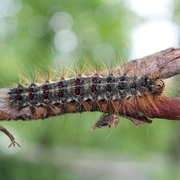West Virginia Proposes Pest Treatment to 3,500 Acres of Forested Land
The West Virginia Department of Agriculture (WVDA) is working with the United States Department of Agriculture-Forest Service (USDA-FS) to control one of the most serious forest pests in the state, gypsy moths. The WVDA Cooperative State-County-Landowner (CSCL) Suppression Program proposes aerial treatment of approximately 3,521 acres of forested lands to reduce significant impacts caused by the gypsy moth.
“Large numbers of caterpillars are expected in the proposed treatment area. It is likely that many already stressed trees will not be able to withstand an additional heavy defoliation and will die,” explains Commissioner of Agriculture Kent Leonhardt. “Water quality, recreation experiences, wildlife habitat and timber production could all be negatively affected.”
The gypsy moth is a non-native, invasive insect that feeds on more than 500 species of trees and shrubs, including West Virginia hardwoods. Young gypsy moth caterpillars are usually spread by the wind. However, humans are speeding up the process considerably by unwittingly transporting the pest as eggs or caterpillars on firewood, RVs, campers and other vehicles. WVDA officials caution against the transport of firewood into or out of the state because pests such as the gypsy moth, along with hemlock woolly adelgid, emerald ash borer, and other invasive insects, may be in or on the wood. Owners of RVs and campers are asked to thoroughly inspect and wash their equipment before moving it.
Even with all of these precautions, the gypsy moth has and will continue to spread, leaving site specific treatments as the only way to ward off population explosions and resulting tree mortality.
An increase in the gypsy moth population in Grant, Hardy, Pendleton, Pocahontas and Summers Counties is expected this year. Areas with 500 egg masses per acre (em/ac) or higher were designated for possible treatment through the CSCL program.
The participating landowners signed a contract with the WVDA and paid a deposit confirming that requested treatment for their gypsy moth problem.
The landowners selected the spray material to be used on their property and verified their property boundaries.
The proposed treatment calls for one application of a specific control agent.
These agents are a bacterium known as Btk, which affects young caterpillars with minimum effects on other insects and animals or Mimic (Tebufenozide) which has a very low toxicity to all mammals and aquatic species.
The WVDA consulted with the WV Division of Natural Resources Wildlife Resources biologist concerning the presence of rare, threatened or endangered species issues in the proposed treatment areas. No impacts to any rare, threatened or endangered species are anticipated.
This article originally appeared in the March 2017 issue of the West Virginia Market Bulletin, published by the West Virginia Department of Agriculture.

